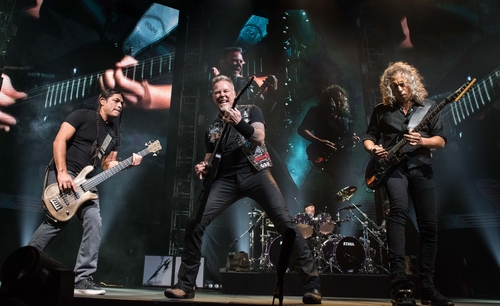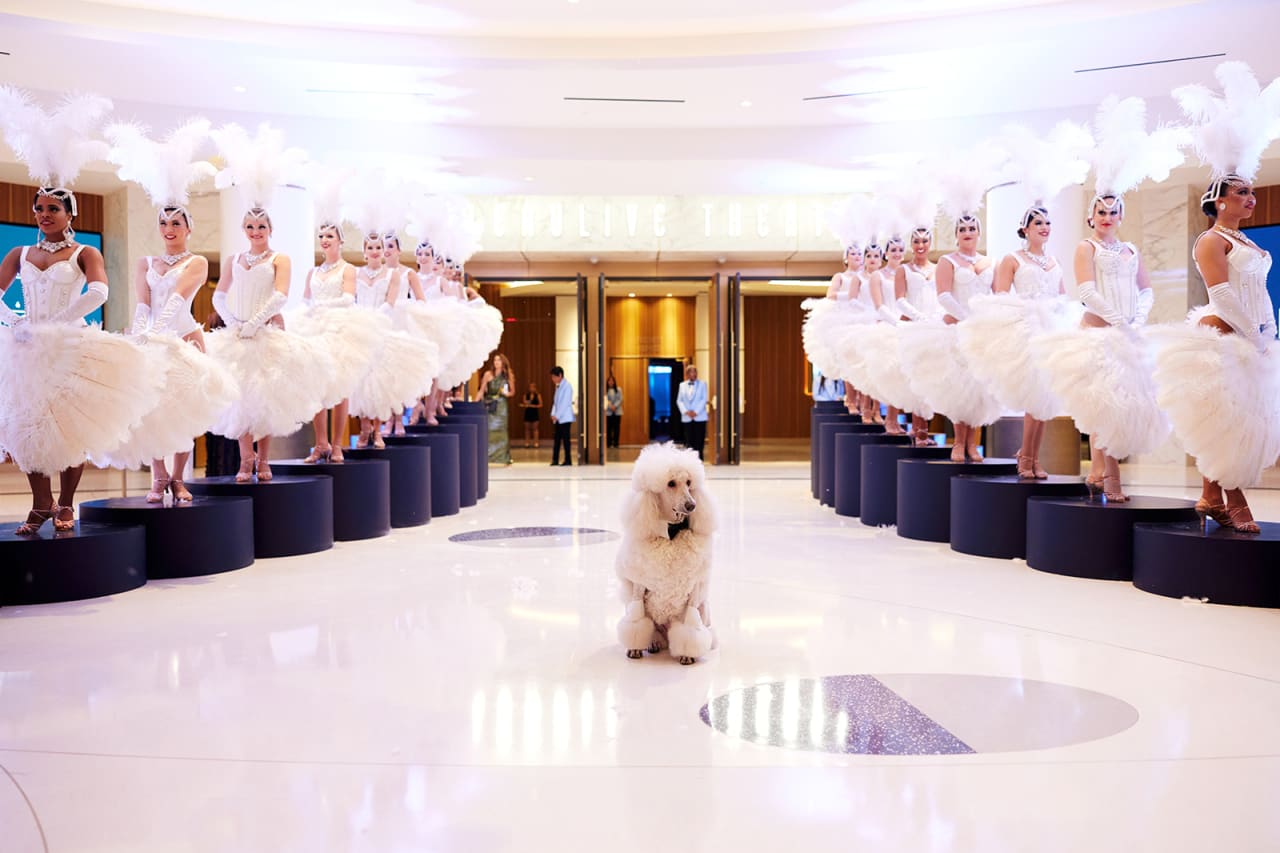Metallica’s European Tour Showcases Renewable-Energy Big Rigs—And Their Limits
The heavy-metal band is using natural gas and vegetable oil to power its 7,200-mile journey, but filling trucks up on sustainable fuels still has a long way to go
Metallica, the band that blazed a trail for thrash metal with rugged guitar riffs and relentless drumbeats, is trying to do something similar for trucks powered by sustainable fuels.
The group, a rock music mainstay since their 1986 hit album “Master of Puppets,” is looking to burnish its bona fides on social issues by using rigs powered by fuels including biomethane and vegetable oil on its European tour this summer.
Working with European truck maker Iveco, the authors of songs including “Battery” and “Fuel” (sample lyric: “Fuel is pumping engines / Burning hard, loose and clean / And I burn, churning my direction / Quench my thirst with gasoline.”) aim to show that sustainable transportation in heavy-duty trucking is possible on European highways dotted with alternative-fuelling stations.
But the trucks’ limitations and the workarounds the band’s logistics providers are undertaking on the meticulously-planned 7,200-mile journey winding through the continent from Sweden to Spain also illustrate how far trucking is from using cleaner fuels in regular operations.
“You have limited options because of the lack of the infrastructure,” said Natasha Highcroft, a director of Suffolk, U.K.-based Transam Trucking, which provides logistics for Metallica and other bands. “We use alternative fuels as and when we can, as much as possible, but until the infrastructure is there it’s very difficult.”
The trucks run on natural gas, vegetable oil, electricity and hydrogen fuel cells, and will be hauling giant video screens, lighting and instruments across nine countries.
The workhorses of Metallica’s tour will be 10 heavy-duty trucks powered by renewable natural gas—such as methane from landfills—and four heavy-duty trucks running on biodiesel or hydrogenated vegetable oil. The trucks, dramatically decked out in Metallica’s fierce logo, can travel about 1,000 miles between refuelling.
Both fuels provide a significant reduction in emissions compared with regular diesel, although emissions experts say they aren’t nearly as clean as battery-electric or hydrogen fuel cell technologies.
The tour was due to kick off this week in Munich, Germany, and over the next two months will cover the continent from Italy and Spain in southern Europe to Denmark and Norway. The longest journey between shows, from Warsaw to Madrid, covers almost 1,800 miles.
Iveco, which is providing the eco-friendly trucks for Metallica’s tour, makes both battery-electric and hydrogen fuel cell big-rig engines, the types that governments in Europe and the U.S. are trying to press on truckers as soon as possible. But because of the lack of charging and fuelling stations on the long legs between gigs, the battery-electric and hydrogen trucks will be mostly for promotional use at concerts, said Gerrit Marx , chief executive of the Italian truck maker.
Marx said Iveco wants to highlight that renewable natural gas and hydrogenated vegetable oil are “more available and ready” than batteries and hydrogen while also being “way better than fossil diesel.”
Europe has hundreds of liquefied natural gas and hydrogenated vegetable oil, or HVO, refuelling stations. A representative for British energy major Shell , which is working with Iveco on the tour, said Metallica’s low-carbon journey wouldn’t have been possible even a couple of years ago.
Shell says its customers can access HVO in five European countries and renewable natural gas in Germany and in the Netherlands. That means that when low-carbon options aren’t available, the Iveco trucks will be fuelled with regular LNG and the HVO trucks will be fuelled with regular diesel.
A Shell representative said the Metallica tour will buy carbon credits to offset “unavoidable emissions“ generated by the low-emission trucks.
U.S. companies are also using renewable natural gas and biodiesel to reduce carbon emissions. But trucking specialists say the fuels aren’t available in sufficient quantities to power the world’s fleets, which is why regulators are pushing battery-electric and hydrogen fuel cell vehicles.
Trucking executives say the costs of operating those technologies are double or triple those of diesel and that they aren’t workable in a highly-competitive, low-margin industry like trucking.
Lars Stenqvist , chief technology officer at truck maker Volvo Group , said it is important that high-profile performers like Metallica amplify the capabilities of sustainable fuels.
Truckers will only adopt the technology when customers demand it, he said, so “This is music to my ears.”
 Copyright 2020, Dow Jones & Company, Inc. All Rights Reserved Worldwide. LEARN MORE
Copyright 2020, Dow Jones & Company, Inc. All Rights Reserved Worldwide. LEARN MORE
This stylish family home combines a classic palette and finishes with a flexible floorplan
Just 55 minutes from Sydney, make this your creative getaway located in the majestic Hawkesbury region.
Continued stagflation and cost of living pressures are causing couples to think twice about starting a family, new data has revealed, with long term impacts expected
Australia is in the midst of a ‘baby recession’ with preliminary estimates showing the number of births in 2023 fell by more than four percent to the lowest level since 2006, according to KPMG. The consultancy firm says this reflects the impact of cost-of-living pressures on the feasibility of younger Australians starting a family.
KPMG estimates that 289,100 babies were born in 2023. This compares to 300,684 babies in 2022 and 309,996 in 2021, according to the Australian Bureau of Statistics (ABS). KPMG urban economist Terry Rawnsley said weak economic growth often leads to a reduced number of births. In 2023, ABS data shows gross domestic product (GDP) fell to 1.5 percent. Despite the population growing by 2.5 percent in 2023, GDP on a per capita basis went into negative territory, down one percent over the 12 months.
“Birth rates provide insight into long-term population growth as well as the current confidence of Australian families,” said Mr Rawnsley. “We haven’t seen such a sharp drop in births in Australia since the period of economic stagflation in the 1970s, which coincided with the initial widespread adoption of the contraceptive pill.”
Mr Rawnsley said many Australian couples delayed starting a family while the pandemic played out in 2020. The number of births fell from 305,832 in 2019 to 294,369 in 2020. Then in 2021, strong employment and vast amounts of stimulus money, along with high household savings due to lockdowns, gave couples better financial means to have a baby. This led to a rebound in births.
However, the re-opening of the global economy in 2022 led to soaring inflation. By the start of 2023, the Australian consumer price index (CPI) had risen to its highest level since 1990 at 7.8 percent per annum. By that stage, the Reserve Bank had already commenced an aggressive rate-hiking strategy to fight inflation and had raised the cash rate every month between May and December 2022.
Five more rate hikes during 2023 put further pressure on couples with mortgages and put the brakes on family formation. “This combination of the pandemic and rapid economic changes explains the spike and subsequent sharp decline in birth rates we have observed over the past four years,” Mr Rawnsley said.
The impact of high costs of living on couples’ decision to have a baby is highlighted in births data for the capital cities. KPMG estimates there were 60,860 births in Sydney in 2023, down 8.6 percent from 2019. There were 56,270 births in Melbourne, down 7.3 percent. In Perth, there were 25,020 births, down 6 percent, while in Brisbane there were 30,250 births, down 4.3 percent. Canberra was the only capital city where there was no fall in the number of births in 2023 compared to 2019.
“CPI growth in Canberra has been slightly subdued compared to that in other major cities, and the economic outlook has remained strong,” Mr Rawnsley said. “This means families have not been hurting as much as those in other capital cities, and in turn, we’ve seen a stabilisation of births in the ACT.”
This stylish family home combines a classic palette and finishes with a flexible floorplan
Just 55 minutes from Sydney, make this your creative getaway located in the majestic Hawkesbury region.






















